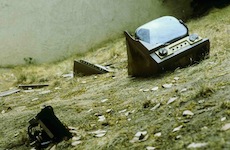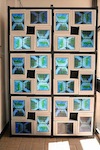Nam June Paik
Something Pacific (1986)
Off Exhibit Through Spring 2025 Due to Construction of New Marshall College
Nam June Paik (1932-2006) was born in Korea, but moved to New York City in 1964. He is frequently referred to as "the grandfather of video art." Paik began his career as a composer and musician studying at the University of Tokyo, the University of Munich, and the Conservatory of Music in Freiburg, Germany. Influenced by the composer John Cage, Paik's interests brought him into the orbit of Fluxus, an international postwar movement of artists — many of whom were influenced by the earlier work of Duchamp and Dada — who sought to break down the barriers between high art and everyday life. Fluxus is often considered "anti-art" in its sometimes-violent renunciation of conventional definitions of the art object.
Paik was first drawn to video in the context of his music; it was the random quality of the television soundtrack that initially appealed to him. For over three decades, however, he was a provocative and prophetic spokesman for new uses of television technology and for the relevance of TV to art. He used television sets in startling constructions for performances (i.e., the TV as cello, bra, or glasses) and designed installations composed of televisions transformed into aquariums, and stacked as pyramids. Paik also made TV chairs and many versions of TV robots. He combined fast-paced video clips — often dramatically colorized — in high-energy montages programmed over several television monitors. Paik was a pioneer in combining straight or manipulated segments of broadcast TV with artist-produced videos, organized by a complex visual and aural matrix.
Paik's Something Pacific for the Stuart Collection was his first permanent outdoor installation. This work relates specifically to its site, which includes the lobby of the university's Media Center as well as the lawns surrounding the building. Outdoors, the work features several ruined televisions embedded in the landscape; some are paired with Buddhas, and one, a tiny Sony Watchman, is topped by a miniature reproduction of Rodin's Thinker.
In striking contrast to this video graveyard, the lobby of the Media Center houses Paik's lively interactive bank of TV monitors. Viewers are able to manipulate sequences of Paik's own tapes and broadcast TV. In accordance with Nam June Paik’s wishes, this live video installation has been periodically renovated and updated with new technologies by current UCSD engineering students.
Like much of Paik's art, Something Pacific's outdoor and indoor sections use the video medium to contrast two very different experiences of time — one involving extended contemplation and the other instantaneous reaction. More importantly, the scattered ruins of televisions offer a cautionary tale for those entering the Media Center. Paik places televisions in the landscape in order to dramatize his belief that television has defined the American landscape since World War II. The outdoor TVs are all "dead" sets, skeletal remains that Paik has returned to nature, perhaps to be discovered in future archeological digs.
Photography
--insert 'paik' module here--


